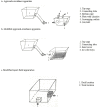Individual differences in rat sensitivity to CO2
- PMID: 33481851
- PMCID: PMC7822239
- DOI: 10.1371/journal.pone.0245347
Individual differences in rat sensitivity to CO2
Abstract
Feelings of fear, anxiety, dyspnea and panic when inhaling carbon dioxide (CO2) are variable among humans, in part due to differences in CO2 sensitivity. Rat aversion to CO2 consistently varies between individuals; this variation in aversion may reflect CO2 sensitivity, but other personality traits could also account for individual differences in aversion. The aims of this study were to 1) assess the stability of individual differences in rat aversion to CO2, 2) determine if individual differences in sweet reward motivation are associated with variation in aversion to CO2, and 3) assess whether variation in aversion to CO2 is related to individual differences in motivation to approach gains (promotion focus) or maintain safety (prevention focus). Twelve female Sprague Dawley rats were exposed multiple times at three different ages (3, 9 and 16 months old) to CO2 in approach-avoidance testing to assess motivation to avoid CO2 against motivation to gain sweet rewards. Rats were also tested for motivation to find hidden sweet rewards, and for their motivation to approach rewards or darkness. Tolerance to CO2 increased with repeated exposures and was higher at older ages. Individual differences in aversion to CO2 were highly repeatable but unrelated to motivation for sweet rewards or the strength of promotion and prevention focus. These results indicate that individual differences in aversion to CO2 reflect variation in CO2 sensitivity.
Conflict of interest statement
The authors have declared that no competing interests exist.
Figures







Similar articles
-
Evidence for consistent individual differences in rat sensitivity to carbon dioxide.PLoS One. 2019 Apr 24;14(4):e0215808. doi: 10.1371/journal.pone.0215808. eCollection 2019. PLoS One. 2019. PMID: 31017958 Free PMC article.
-
Variation in the onset of CO2-induced anxiety in female Sprague Dawley rats.Sci Rep. 2019 Dec 12;9(1):19007. doi: 10.1038/s41598-019-55493-0. Sci Rep. 2019. PMID: 31831816 Free PMC article.
-
Differential behavioral sensitivity to carbon dioxide (CO2) inhalation in rats.Neuroscience. 2017 Mar 27;346:423-433. doi: 10.1016/j.neuroscience.2017.01.003. Epub 2017 Jan 11. Neuroscience. 2017. PMID: 28087339 Free PMC article.
-
Understanding rat emotional responses to CO2.Transl Psychiatry. 2020 Jul 24;10(1):253. doi: 10.1038/s41398-020-00936-w. Transl Psychiatry. 2020. PMID: 32709846 Free PMC article. Review.
-
[Effects of anxiolytic drugs on rewarding and aversive behaviors induced by intracranial stimulation].Nihon Shinkei Seishin Yakurigaku Zasshi. 2004 Jun;24(3):111-8. Nihon Shinkei Seishin Yakurigaku Zasshi. 2004. PMID: 15291239 Review. Japanese.
Cited by
-
Mouse aversion to induction with isoflurane using the drop method.Lab Anim. 2025 Apr;59(2):169-177. doi: 10.1177/00236772241262119. Epub 2024 Oct 4. Lab Anim. 2025. PMID: 39364664 Free PMC article.
-
Using approach latency and anticipatory behaviour to assess whether voluntary playpen access is rewarding to laboratory mice.Sci Rep. 2021 Sep 21;11(1):18683. doi: 10.1038/s41598-021-98356-3. Sci Rep. 2021. PMID: 34548608 Free PMC article.
-
Associations of CO2 reactivity and orexin activity with extinction memory to fear and reward cues: results from a large sample of male rats across multiple studies.Physiol Behav. 2025 Sep 1;298:114949. doi: 10.1016/j.physbeh.2025.114949. Epub 2025 May 9. Physiol Behav. 2025. PMID: 40350068
-
Rats move nesting materials to create different functional areas: Short report.Lab Anim. 2023 Feb;57(1):75-78. doi: 10.1177/00236772221122132. Epub 2022 Sep 29. Lab Anim. 2023. PMID: 36173016 Free PMC article.
-
Environmental Enrichment for Rats and Mice Housed in Laboratories: A Metareview.Animals (Basel). 2022 Feb 9;12(4):414. doi: 10.3390/ani12040414. Animals (Basel). 2022. PMID: 35203123 Free PMC article. Review.
References
Publication types
MeSH terms
Substances
LinkOut - more resources
Full Text Sources
Other Literature Sources
Medical

